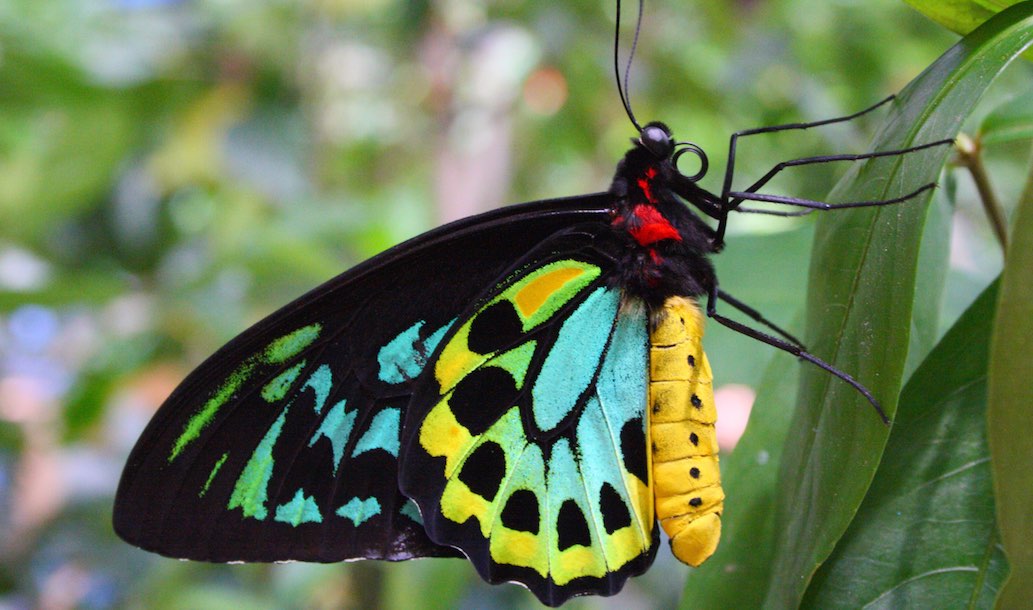A threatened butterfly species now has improved prospects for survival thanks to determined residents and a community development grant from the Ipswich City Council.
The Springfield Lakes Nature Care group wants to give residents a free birdwing butterfly vine to bring the butterfly back.
The Richmond birdwing butterfly is disappearing.
It is the largest butterfly in subtropical eastern Australia but most people probably don’t have one in their garden.
Female Richmond birdwing butterfly. Image: Richard Bull
The Richmond birdwing butterfly
The Richmond birdwing is one of Australia’s largest butterflies with a wingspan of up to 16 cm in females and 13 cm in males.
Males and females differ in appearance.
Females have dark brown or black wings with extensive white, cream or, in the hindwing, yellowish markings.
The upper forewing of males is black with a distinctive iridescent green leading edge, while the upper hindwing is predominantly iridescent green with black spots.
Eggs are roughly spherical, approximately 2 mm in diameter and bright yellow or brownish-yellow.
They are laid on the undersides of soft leaves of the food plant.
Larvae develop through five stages (instars), moulting their skins between each stage.
Wildlife Queensland projects manager Matt Cecil said the Richmond birdwing butterflies’ caterpillars will only eat a specific plant type.
“The female butterfly needs a birdwing butterfly vine (pictured above). The hatched larva only eat this vine,” Mr Cecil said.
“In order to help the Richmond birdwing, we must plant the vine.
“Any vine planting can be complimented by planting a native plant that has nectar rich flowers, including bottle brush lillypilly and Grevillea.”
The butterflies have been sighted at Indooroopilly, just over 10km away as the butterfly flies, and in the D’Aguilar Range near Brookfield.
In 1870 the butterfly was reported in newspapers as occurring in the thousands on the streets of Brisbane.
Much of this land was eagerly sought after for agriculture and since 1926 there had been a massive decline in butterfly numbers.
A modern threat to the Richmond birdwing butterfly is a toxic week called Dutchman’s pipe vine (Aristolochia elegans).
Dutchman’s pipe vine
A female butterfly will lay eggs on the leaf and once the eggs hatch, the larva feed on the leaf of the plant and are poisoned.
Mr Cecil said this plant is a real threat to the Richmond birdwing and needs to be removed wherever it is found growing.
The once abundant butterfly is now listed as vulnerable and has become extinct in two-thirds of its original range.
The butterflies’ preferred habitat is dry rainforest, which still exists in patches along the Brisbane River and up Woogaroo and Opossum Creeks.
The Springfield Lakes Nature Care group is holding a workshop on Sunday, 10 November at the Springfield Central Library, to invite residents to receive a free birdwing butterfly vine and learn how to care for it.
Dr David Manning in particularly keen for residents in the Greater Springfield area and suburbs along Woogaroo Creek such as Bellbird Park, Camira and Goodna to attend.
The flower of the birdwig butterfly vine. Image: Richard Bull
Birdwing butterfly vine
The birdwing butterfly vine (Pararistolochia praevenosa) is a climbing liana. A liana is a long-stemmed, woody vine that is rooted in the soil at ground level and uses trees to climb up to the canopy.
In natural habitats the vines usually occur in gullies or on moist lower slopes of mountain ranges.
Flowering occurs mainly from September to November and, dependent on rainfall, it can flower at other times.
Flowers appear on stems receiving sunlight and are pollinated by small flies (Diptera, possibly Phoridae) that breed in decomposing leaf litter.
Seed capsules begin to expand in spring, ripening in late summer and autumn.
When mature they fall to the ground where Australian brush-turkeys (Alectura lathami) feed on the pulp, inadvertently burying seeds by scratching.
It is currently growing in the Sunshine Coast region and Gold Coast region and through the D’Aguilar Ranges and Upper Ormeau Tamborine, Canungra and McPherson Range.
It also extends into northern New South Wales.
Image: Leo Lymburner/Big Scrub Landcare
“The butterflies can sense the vine’s presence from many kilometres away, so it is hoped that they will be attracted to our suburbs,” Dr Manning said.
“The plantings will strengthen the gene pool of the butterfly and allow genetic mixing amongst the current population, by enabling them to travel from the D’Aguilar Range to other habitats along the Brisbane River and join corridors along Teviot Brook and the Logan River to Mt Tamborine.”
Richmond Birdwing Butterfly Vine workshop will be held on Sunday, 10 November at 1pm until 2.45pm, at the Springfield Central Library, Sirius Drive, Springfield Central.
Participants will receive a free Richmond Birdwing Butterfly Vine to plant in their backyard and information on how to care for and re-pot the vine.
Illustration: Wildlife Preservation Society of Queensland

